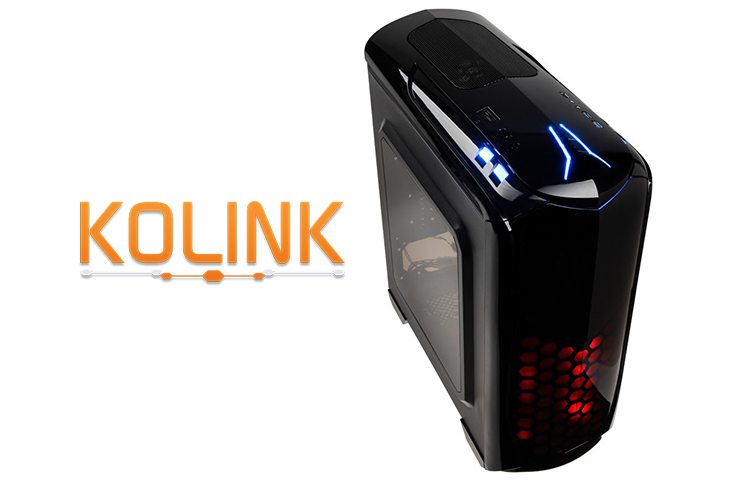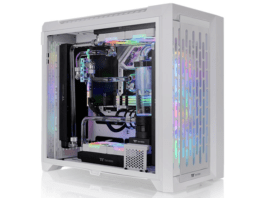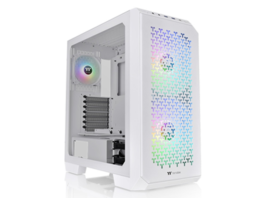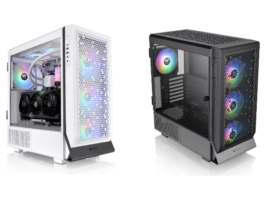[section_title title=”Introduction”]
Introduction
Kolink..? Let’s start with a who. Kolink is a company that offer a value oriented range of products towards gamers, currently offering cases and power supplies– although they have offered bare-bones systems in the past in the form of their Klick series.
Past this you don’t really find much information on Kolink, their website is pretty empty and doesn’t even feature their own product catalogue.
What Kolink has to say about the Aviator:
“With its aggressive gaming design, the Kolink Aviator is an excellent example of a gaming case that is packed full of features without the hefty pricetag.
The Black Aviator comes with a premium Glossy finish, and 3 pre-installed fans, 2 of which are Red LED. The Aviator comes with support for up to 370mm VGA cards, 170mm CPU Coolers and 240mm Radiators on the top or front panel.
Furthermore, the Aviator comes with 2 x USB3.0 ports at standard, an TF/SD Card Reader and a fan controller for excellent user interface options.”
So, let’s have a look at the Kolink Aviator and see whether or not it is as good value as Kolink state.
Specifications
| Model | Kolink Aviator V |
| Motherboard Support | ATX, Micro-ATX, Mini-ITX |
| Dimensions | 400mm(L) x 211mm(W) x 490mm(H) |
| Maximum GPU Length | 370mm |
| Maximum CPU Cooler Height | 170mm |
| 5.25″ Drive bays | 2 |
| 3.5″ Hard Drive bays | 3 |
| 2.5″ Hard Drive bays | 2 |
| Expansion Slots | 7 |
| Fans included | 2x 120mm (front), 120mm (rear) |
| Cooling Layout | Front: 2x 120mm Rear: 1x 120mm Top: 2x 120mm |
| Radiator Compatibility | N/A |
| Dust Filters | Bottom |
| Front I/O | 2x USB3.0, 1x USB2.0, 3.5mm headphone + microphone, SD card reader, Fan controller |
Closer Look: Exterior
The exterior on the Kolink Aviator is made of a mostly glossy, black plastic finish with an aggressively curved style to add some flash to the case in ways that will do less damage to the budget. This finish is used all over the Kolink Aviator’s exterior barring the ventilation at the top and the side panels- which are the main attraction to the case at this price point. The glossy finish does worry me a little bit as it may age very fast due to the scratch-prone nature of this type of finish.
At the front of the case, there is not a lot worth mentioning, the assembly is made of the glossy black plastic that was mentioned already, only broken by the 5.25″ drive door which provides space for the two bays supported in the Kolink Aviator.

The Kolink Aviator uses a full-view black tinted side window not unlike ones we’ve seen in other cases. However unlike the other cases we’ve seen employ this style of side window the material used is plastic, although given the clarity it’s hard to tell until you pick the panel up and feel the difference in material. This is the main selling point of the case due to its low price and side-window design that currently, has been limited to premium priced mid-tower cases that cost almost twice as much as the Kolink Aviator.
The front I/O is situated on the top panel of the aviator- a position that I personally like as it avoids issues such as flash drives getting caught if someone is to walk past the case, or if you catch it with your leg under a desk. The Kolink Aviator offers a total of three USB ports on the front- of which two are USB3.0 which is nice to see, particularly at a lower cost. There is also an SD Card slot which isn’t common for many cases but is a nice addition for those who use SD Cards and adapters frequently, but some may have favoured an extra USB 2.0 slot which is more universal. Along with this are the standard 3.5mm headphone & microphone jacks.
At the bottom of the Kolink Aviator, there are four large rubber-based feet and a perforated area where the bottom mounted power supply can intake air from. The Kolink Aviator also comes with a rather rudimentary removable dust filter which is clearly an area Kolink chose to cut some corners on this case to bring other features, although many cases in the lower price range do not offer filters at all so it is certainly better than nothing.
At the back of the case, there are the 7 expansion slots for peripheral expansion, the rear 120mm fan grill and the space for the bottom mounted power supply. Past this, there is not a lot to say about the back of the Kolink Aviator.
Closer Look: Interior
Removing the side-window on the Kolink Aviator reveals a fairly standard layout that is used in most cases today, with a bottom mounted power supply and the drive bays occupying the space to the right of the motherboard tray. The interior of the Kolink Aviator is quite small considering the overall size of the case, due to the fairly large plastic construction surrounding the inner frame- a reverse tardis, if you will. This could make installation of some hardware difficult, although the Kolink Aviator does include cable routing holes for basic cable management.
With the purchase of the Kolink Aviator, you get a black and white printed manual showing the intended purpose of each screw, as well as a bag of assorted screws (including extras) for completing the build in the Kolink Aviator. Among the provided screws are rubber insulated mounting screws for 3.5″ HDDs.
 The cables for the front panel connections are pre-routed to the bottom of the case, sadly they do suffer from what I like to call “rainbow cable”. It’s much nicer if they have a black finish given the side window, but considering the fairly low price point of the Kolink Aviator, it is excusable. The remaining front panel cables (namely; the fan controller) are routed at the rear of the case. The fan controller uses a Molex connection which is a bit disappointing for users with modular power supplies, as the interior is already quite packed. One thing that Kolink did think to include was a USB2.0 adapter for the USB3.0 ports, as not all cheaper motherboards, particularly on the budget-oriented AMD platforms, feature front USB3.0.
The cables for the front panel connections are pre-routed to the bottom of the case, sadly they do suffer from what I like to call “rainbow cable”. It’s much nicer if they have a black finish given the side window, but considering the fairly low price point of the Kolink Aviator, it is excusable. The remaining front panel cables (namely; the fan controller) are routed at the rear of the case. The fan controller uses a Molex connection which is a bit disappointing for users with modular power supplies, as the interior is already quite packed. One thing that Kolink did think to include was a USB2.0 adapter for the USB3.0 ports, as not all cheaper motherboards, particularly on the budget-oriented AMD platforms, feature front USB3.0.
The motherboard tray has support for mini-ITX, micro-ATX and ATX. Unsurprisingly there is no support for E-ATX and other large formats. Kolink wisely considered that the platforms using those form factors are likely outside of the target market for the Kolink Aviator. The stand-off screws are not pre-installed, instead, they are included in the accessory bag you get with the case. Kolink did leave small letter markings indicating which form factor uses which stand-off, though, which is always nice for first time builders.
At the back of the case is the pre-installed 120mm fan which is of none-LED design, the fan uses a 3 pin connector. The fan is of Kolink branding but the sticker does not reveal any series it may belong to. The rear of the case also gives a blast from the past with the break-off peripheral expansion brackets, this is massively disappointing as the industry has moved past this design now. Kolink does provide two replacement brackets however which can be screwed in, but at that point, I feel it would’ve been much better to simply make all 7 expansion slots have replaceable expansion brackets.
 At the bottom of the case is the area for the bottom mounted power supply, within the accessories pack Kolink provide a small bit of foam that you can stick to the bottom of the case to insulate vibrations from the power supply, which is a nice touch. There is plenty of space for pretty much any power supply on the market including modular units. Although longer power supplies will block some of the cable routing hole at the bottom of the case.
At the bottom of the case is the area for the bottom mounted power supply, within the accessories pack Kolink provide a small bit of foam that you can stick to the bottom of the case to insulate vibrations from the power supply, which is a nice touch. There is plenty of space for pretty much any power supply on the market including modular units. Although longer power supplies will block some of the cable routing hole at the bottom of the case.
Kolink placed the drive bay at the lower right-hand side of the case, it supports three 3.5″ drives and offers mounting space for a single 2.5″ drive, this bay is non-removable. Kolink wisely placed it here rather than attaching it to the 5.25″ drive bay otherwise, this bay would’ve massively hindered graphics card compatibility. Three drives are not as many as some cases support but for the target market, I feel it is sufficient.
Up at the top of the Kolink Aviator is the optical drive area which supports two 5.25″ drives, this could’ve probably been left out to increase room inside the Kolink Aviator as optical media is very much an outgoing standard when it comes to computer games, but some users will appreciate the addition. The top bay appears to be somewhat blocked by the pre-routed cables which are a bit of an oversight. The bays use a plastic clamping mechanism to keep the drive(s) in place.
Upon removing the plastic front panel the two pre-installed 120mm LED fans can be found, these fans are also Kolink branded, past this, there is not much other than the large area for the optical drive bays.
 Removing the top panel reveals what looks like it could support an installation of a water-cooling radiator given the extra spacing on the screw holes, but radiator support is not listed. There were also some signs of the cost savings Kolink took as the finish on the metal construction is not complete in areas.
Removing the top panel reveals what looks like it could support an installation of a water-cooling radiator given the extra spacing on the screw holes, but radiator support is not listed. There were also some signs of the cost savings Kolink took as the finish on the metal construction is not complete in areas.
The Build
The Kolink Aviator is- as I expected. Not the easiest case to build in compared to more expensive offerings, but it’s certainly doable. Some of the hardware used in this build is likely outside of the intended market given the price point of the case. I started by installing the power supply in the bottom of the case, without the included dampening foam mentioned previously the large unit here was too big for the cases built in power supply feet.
With the power supply in I attempted to install the motherboard, but the pre-routed cables for the front panel connectivity blocked installation of the ATX board used in this build, which also seems to be a bit of an oversight in the routing of the cables. With the cables re-routed it was possible to get the motherboard in, but it was a bit tight. The drive bay may also block SATA ports for boards that feature right-angle SATA connections.
Installing the 3.5″ HDD was straightforward, the design requires you to screw two of the rubber insulated screws on either side of the drive then slide it into the bay. The bay does have a thumbscrew which seems bit be for a locking mechanism but it didn’t seem to do anything on my sample. Installing the 2.5″ drive was not so simple, the space on top of the 3.5″ HDD bay was not enough to install the 2.5″ drive with the connectors installed. Luckily there is a second spot on the rear of the motherboard tray, however, if you plan to use this you must install the SSD before the motherboard, which is a bit annoying.
Installing the graphics card was easy, given that the Kolink Aviator supports pretty much any card with the generous 370mm length allowed. The card used was the EVGA GTX980 classified which is quite large, so I don’t see there being any problem with single graphic card solutions in the Kolink Aviator, although support for two cards is limited by the motherboards’ spacing- as the 3.5″ drive bay may impede on the installation of additional cards.
The hardest part of the build was getting all cables installed neatly, the seemingly larger than intended hardware installed in the Kolink Aviator blocked the use of the routing holes in the motherboard tray, but it was still possible to do an acceptable job with the cables by routing them around the surplus space around the graphics card. Overall the Kolink Aviators cable options are acceptable for a case of its price, it doesn’t stand out but it isn’t terrible either.
As the top of the case looked like it could support the installation of a 240mm radiator, I explored this possibility. I attempted to install an Asetek all in one liquid cooling unit but did not have any luck, the radiator (just) fit in the space above the case but installing fans wasn’t possible without interfering with the installed memory and the motherboards heatsink. The installation will also require the removal of the rear installed 120mm fan.
With that, I instead opted to use the Hyper 212 EVO cooler which fits well within the Kolink Aviators specified 170mm cooler height limit.
Overall I was happy with what I managed to achieve in the Kolink Aviator, given more favourable hardware the Kolink Aviator would’ve held up better with cable routing. It was still possible to build a clean looking system in the case- which you definitely want to do with the full-view side window.
I do also like that Kolink used a raised rear-side panel rather than one that was completely flat, less expensive cases often have problems with cables routed behind the motherboard, but the inclusion of this side panel in the Kolink Aviator meant that I had no issues getting the panel back on once the build was complete.
Conclusion
The Kolink Aviator is clearly targeted towards people looking to build gaming systems on a budget with the aggressive aesthetic and inclusion of LED lighting. An added bonus which isn’t common at the low asking price of the Kolink Aviator is the full-view window. The Kolink Aviator offers a decent building experience also, it isn’t exceptional but doesn’t leave you frustrated. Installing most hardware is not difficult which makes it ideal for first-time buyers on a budget.
Also, Kolink Aviator also offers a good selection of front I/O with the dual USB3.0 connectivity and SD card reader, as well as the generous number of pre-installed fans. Because of that, the thermal performance is very good which can’t be said for all cases at lower price points. The case isn’t silent, the pre-installed fans do give off a fair amount of noise but it is not obnoxious.
The main pitfall of the Kolink Aviator is as expected at this price range – the build quality. The glossy plastic material on the outside is easy to scratch with little effort, which could leave the Kolink Aviator looking worse for wear compared to other cases its price point after extended use. The build is also very noticeably- plastic, other cheaper cases offer a more premium finish using techniques such as brushing to give off the impression the cost is more than it may have been. Also; the construction of the metal frame inside the Kolink Aviator is rather thin and bends very easily with minimal force from my hand to hold the case in place when I installed the drives bent the metal construction.
No compatibility for 240mm radiators is a bit of a shame, but at the given price point is not a deal-breaker given that most 240mm units cost more than the case itself. Another problem with the Kolink Aviator that comes to mind is the not as well thought out 2.5″ drive solution, the spot above the 3.5″ bay isn’t very accessible for cables and the spot behind the motherboard requires placement of the drive before installation of the motherboard, which most people tend not to do.
Overall, the Kolink Aviator is a solid choice at its price point for those looking for a good side window and an aggressive gamer style aesthetic with LED lighting. It takes features we like from more expensive cases and makes them available at an accessible price point. As a case, it is nothing to write home about but does the job well enough to not be a poor product. I feel that the Kolink Aviator needs more internal space, as the area inside the case is quite small compared to the case itself- which makes it seem a little wasteful. The extra space could be used to make hardware installation easier, offer a better 2.5″ drive solution or to improve cable management between components.
With this in mind, I feel the Kolink Aviator is fitting for the Play3r Silver Award. It offers good thermal performance and good looks at an affordable price point but cuts back in some areas that hurt the building experience. With a few improvements, the Kolink Aviator could be a great case at its price. As it is, it’s a good option if you like the aesthetic and really want a full panel window.
Want to learn more about our awards here at Play3r? Click here.
This review sample was provided by Overclockers.co.uk, to whom we extend our thanks.
-
Performance
-
Design
-
Value
Summary
Pros:
– £46 is a bargain for a case with the features offered
– You either like the design or you hate it; we like it
– 3 x 120mm fans included!
– Front I/O includes an SD card reader
Cons:
– Build quality is as you would expect with a case this price
– Could utilise the interior space better for cable management




















